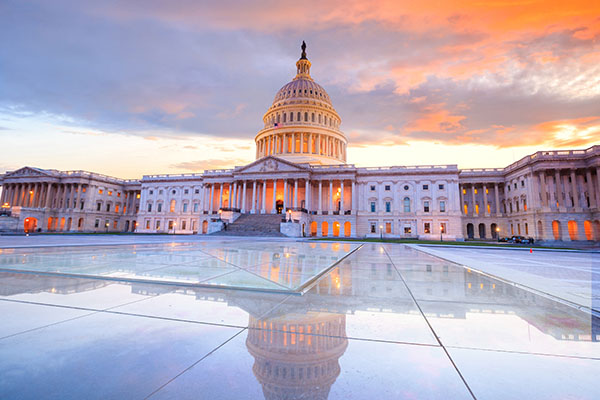New legislation focuses on upping multimodal freight investment
Legislation introduced earlier this month by Senator Tom Carper (D-Del.) takes a hard look at giving non-highway freight-based transportation infrastructure initiatives a more prominent seat at the table.
Legislation introduced earlier this month by Senator Tom Carper (D-Del.), whom also serves as the ranking Democrat on the Senate Environment and Public Works Committee, takes a hard look at giving non-highway freight-based transportation infrastructure initiatives a more prominent seat at the table.
Carper’s bill focuses on improving the country’s freight systems through making key investments in ports, railways, and intermodal hubs, with a major emphasis on augmenting the Nationally Significant Freight and Highway Projects program, which is a key freight-related component of the Fixing Americas Surface Transportation Act (FAST Act). The Nationally Significant Freight and Highway Projects program is also known as the Infrastructure for Rebuilding America (INFRA) program, with the program’s chief objective to make needed investments is critical freight and highway needs.
“Our economy relies on domestic and international freight making its way through our ports, railways and intermodal hubs, which serve as gateways to the global marketplace for American farmers, manufacturers and consumers. In the US, our freight network moves 49 million tons of goods every day, which are worth more than $52.5 billion,” said Senator Carper in a statement. “The economic importance of freight movement cannot be overstated, and our ports, railways, and intermodal hubs are a critical part of the multimodal freight system. Regrettably, as a country, we haven’t been making investments in our national transportation system that we need to. That’s why last week, I introduced a bill that would allow ports and railways to compete for more grant funding from the Nationally Significant Freight and Highway Projects Program, or INFRA Grants. And while these discretionary grants make critical investments in freight projects, they are largely limited to highway projects. My bill would remove this limitation and allow ports and railways to compete on equal grounds. We should be investing in the best quality projects that will keep our country moving, and that’s what I intend to do with this bill.”
The key components of Carper’s bill focus on:
- Removing the cap on INFRA grants to multimodal freight projects;
- Enhancing transparency and administration of the INFRA grant program to ensure that the best projects receive funding; and
- Ensuring that safety remains a priority for the INFRA grant program
Carper’s bill received a strong endorsement from the Washington, D.C.-based Coalition for America’s Gateways and Trade Corridors (CAGTC).
CAGTC pointed out that the multimodal freight network directly supports 44 million U.S. jobs and the indirect benefits extend to every corner of the national economy. But it noted that comes with a caveat, as non-highway projects can compete for just 11% of total INFRA program funding
Elaine Nessle, CAGTC executive director, explained that increasing the program’s flexibility by making investments in the best freight projects—regardless of mode—will allow projects with the largest benefit to the goods movement network to be successful, adding that beyond increasing the flexibility of the INFRA program, overall funding levels must be increased to address growing demands on goods movement infrastructure.
“This bill makes great deal of sense because the INFRA program was designed to meet freight needs, and as long as we continue to address freight needs in a stove-piped way, we won’t get the full benefits of a linked multimodal system,” she told LM. “Currently, the INFRA program only allows about 11% of the funding to go to non-highway projects and Senator Carper’s proposal would like to see that entire pot of money under the freight program available to freight projects, regardless of mode to give localities, State DOTs and seaports, or whomever the applicant may be, ultimate flexibility in deciding their highest-priority freight needs regardless of mode.”
What’s more, Nessle said that this bill is really planting a flag in the ground to prepare for the next surface transportation reauthorization.
“The FAST Act expires at the end of 2020, and that will be here before we know it,” she said. “In the next Congress, the relative committees will really begin putting pen to paper and thinking about what the next surface transportation authorization should look like, what improvements should be made. We think this bill is a key improvement that could be made. We are constantly talking about constrained funding in Washington, and this improvement Carper is suggesting would not actually cost a nickel. It is just opening up the pot to different types of projects.”
Putting the current precarious state of transportation funding into perspective, Nessle said that the INFRA program is already oversubscribed by about $12 requested for every $1 available in actual funding.
This bill also was firmly supported by the American Association of Port Authorities (AAPA).
“The American Association of Port Authorities strongly supports Senator Carper’s legislative initiative that repeals the multimodal cap on the discretionary grant program created in the FAST Act,” said AAPA President and CEO Kurt Nagle. “Sustainable multimodal funding is a top AAPA priority and the association greatly appreciates the senator’s work to advance legislation that is both timely and very much needed.”
AAPA officials pointed out that of the $11 billion of freight funding provided in the FAST Act, only $1.13 billion is multimodal eligible, and of that, only $200 million in multimodal eligibility remains available for INFRA grants.
In a letter addressed to Senator Carper in August, Nagle wrote that to build off the work in the Fast Act, AAPA believes that freight program funding should be 100% multimodal.
And he explained to Carper that that since the FAST Act required states to complete state freight plans to receive additional FAST Act funding, 90% of states have complied.
“This signals that states recognize the value of multimodal projects, and they recognize that ports are the linchpins for this activity,” noted Nagle.













